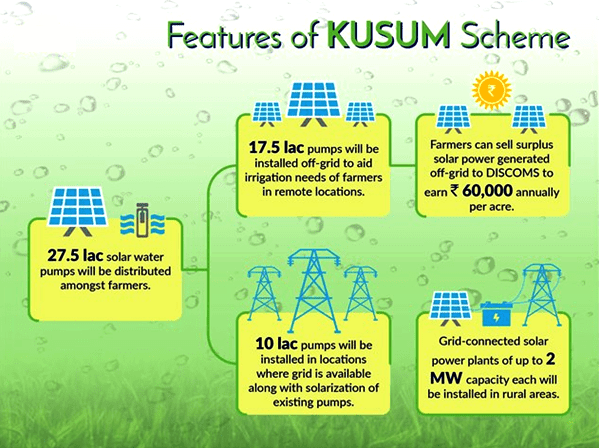Agriculture
PM-KUSUM
- 03 Apr 2021
- 5 min read
Why in News
Recently, the first farm-based solar power plant under the Prime Minister’s Kisan Urja Suraksha Evam Utthan Mahabhiyan (PM-KUSUM) scheme has come up in Jaipur (Rajasthan) district’s Kotputli tehsil with a provision for production of 17 lakh units of electricity every year.
Key Points
- About:
- The PM-KUSUM scheme was launched by the Ministry of New and Renewable Energy (MNRE) to support installation of off-grid solar pumps in rural areas and reduce dependence on grid, in grid-connected areas.
- The Cabinet Committee on Economic Affairs (CCEA) had in February 2019 approved the launch of the scheme with the objective of providing financial and water security.
- The government’s Budget for 2020-21 expanded the scope for the scheme with 20 lakh farmers to be provided assistance to install standalone solar pumps; another 15 lakh farmers to be given help to solarise their grid-connected pump sets.
- This will enable farmers to set up solar power generation capacity on their barren lands and to sell it to the grid.
- Components of the PM-KUSUM:
- PM-KUSUM consists of three components and aims to add a solar capacity of 30.8 GW by 2022:
- Component-A: 10,000 MW of decentralised ground-mounted grid-connected renewable power plants.
- Component-B: Installation of two million standalone solar-powered agriculture pumps.
- Component-C: Solarisation of 1.5 million grid-connected solar-powered agriculture pumps.
- PM-KUSUM consists of three components and aims to add a solar capacity of 30.8 GW by 2022:
- Intended Benefits of the Scheme:
- Helping Discoms:
- Supports the financial health of electricity distribution companies (discoms) by reducing the burden of subsidy to the agriculture sector.
- Help them meet the RPO (Renewable Purchase Obligation) targets.
- Helping States:
- Promotes decentralised solar power production, and reduces transmission losses.
- A potential way to reduce their subsidy outlay towards irrigation.
- Helping Farmers:
- If farmers are able to sell surplus powers, they will be incentivised to save power and, in turn, it will mean the reasonable and efficient use of groundwater. This will also increase their income.
- This may also provide water security to farmers through the provision of assured water sources through solar water pumps — both off-grid and grid-connected.
- Helping Environment:
- Expansion of the irrigation cover by providing decentralized solar-based irrigation and moving away from polluting diesel.
- Helping Discoms:
- Concerns:
- Logistics Issue:
- There is a matter of domestic availability of equipment itself. While pumps are not a challenge for domestic suppliers, the availability of solar pumps is still an issue.
- Further, due to the strict DCR (Domestic Content Requirements), the suppliers of solar equipment have to raise the domestic cell sourcing. However, there isn’t enough domestic cell manufacturing capacity.
- Omission of Small and Marginal Farmers:
- There has been the relative omission of small and marginal farmers, as the scheme focuses on pumps of 3 HP and higher capacities.
- It is due to this, solar pumps are not reaching the majority of farmers, as nearly 85% of them are small & marginal.
- Also, the reality of low water tables, especially in North India and parts of South India, which make small-sized pumps limiting for the farmer.
- Depleting Water Tables:
- Due to power subsidies, the recurring cost of electricity is so low that farmers keep on pumping water and the water table is going down.
- In a solar installation, it becomes a more difficult job to upgrade to higher capacity pumps in case the water table falls because one will have to add new solar panels which are expensive.
- Logistics Issue:
Way Forward
- Consensus between the Centre and States is the key to the success of this decentralised solar power scheme. Any reform in India’s power space cannot take place unless there is consensus between the Centre, States and stakeholders.
- Apart from switching to solar power, farmers should also switch over to drip irrigation mode which saves water and power with increased crop output.
- For effective implementation and serious participation by stakeholders, the scheme should be more attractive in terms of benchmark prices in view of the challenges on account of higher costs of implementation and comprehensive maintenance.







